Filippo Brunelleschi built a perspective device that combined a rendering of the Florence baptistery with a mirror. Its story is one of the origin myths of the art and science of perspectival projection—of what the Florentine renaissance called costruzzione leggitima. Brunelleschi painted a small picture of the Florentine baptistery, which is located directly opposite the entrance of the Florentine cathedral. This picture and the accompanying apparatus were to provide a demonstration of a new technique, which we now call perspective. But Brunelleschi wanted his picture not just to show this technique, but also to demonstrate its accuracy, its special ability to put objects in space and in correct relation to one another. So he provided the beholder an apparatus that would permit each beholder to demonstrate to himself the validity of Brunelleschi’s technique.
Brunelleschi drilled a small hole in the painted panel, so the beholder could look through the hole at the mirror and see the perspective construction in the mirror. The apparatus, including the painting and the mirror, was small, which allowed the beholder to hold it easily, and even to hold it at the very place—a point three braccia inside the door of the Florentine cathedral opposite the baptistery—from which the view was projected (fig. 1).

Now, regardless of where the picture was seen, it would have offered a convincing likeness of the baptistery. Furthermore, the mirror might have enhanced the beholder’s experience of the panel’s verisimilitude, regardless of where this device might have been used. But, used at precisely the right place, just inside the doors of the cathedral, it would have done something crucially different. Restricted to a single eye’s point of view and aided by the mirror, the beholder could have judged the conformity of the image in the painting to the view of the baptistery available from that privileged point of view. The picture was an example of the new technique of perspectival projection; the apparatus was a device for proving the technique’s claim.
In his discussion of this device, Hubert Damisch aligns the painting with “showing” and the mirror with “demonstrating.”1 The painting shows the baptistery and some part of the surrounding square. The mirror, on the other hand, makes nothing new visible. It only shows the painted scene in relation to the real place. Rather than offer a new prospect, it does something called demonstrating, which Damisch understands in the sense of demonstrating the truth of a theorem or the guilt or innocence of an accused person. The mirror establishes the truth of the painting’s claim. But, and this is a crucial point, it can only do so for a single eye that occupies a particular point, which is determined rigorously by the perspectival projection. Perhaps it is worth noting that Brunelleschi’s device is constructed in terms of the user’s body, and specifically in terms of braccia—a measure derived from the length of the forearm. Thus, the panel is just over half a braccia square. The mirror is to be held at an arm’s length—at one braccia—and at a point precisely three braccia inside the door of the cathedral. It is as if Brunelleschi’s apparatus were a machine for extending a rationalized abstraction of the human arm throughout the modules of a grid that carried to infinity the body of the beholder.
Damisch compares the function of the mirror in Brunelleschi’s apparatus with the mirror in Jan van Eyck’s Arnolfini picture (Damisch, 129-31). Referring to Erwin Panofsky’s thesis that the picture fulfills the function of a legal document, Damisch points to the famous signature—“Jan van Eyck was here”—and its conjunction with the mirror as something similar to the evidentiary structure in Brunelleschi’s apparatus. Both locate the subject at a precise position and do so for the more or less literally legal purpose of demonstrating their relation to a place, to a situation. Of course, in this, it is also unlike Brunelleschi’s apparatus, since one needn’t maintain a specified position. I think this is significant, so I will return to it presently.

First, let us ask: How will all of this help us understand Joan Miró’s politics? He did not use costruzzione leggitima or anything much like it. Few modernists did. Nevertheless, Damisch heaps scorn on the idea that perspective’s reign ended in modernism (Damisch, 35ff). This is part of his general rethinking of the notion of perspective’s history as a trajectory from origin to demise. Rather than ask whether this age or that culture used perspective, he asks instead what perspective they had (Damisch, 12-13). Accordingly, to take one example, he recuperates the multiple viewpoints of post-Cézannian painting for an enlarged notion of perspective by invoking a collection of miniature cones of vision, each cast eccentrically like a glance or a stare from a mobile subject (Damisch, 35-37) (figs. 2 and 3). But this continuation of perspective leaves aside the question of the mirror—of the literal mirror, of Brunelleschi’s mirror. The regime, as it were, of Brunelleschi’s demonstration surely has a history of its own in modernism. Perhaps Juan Gris’s Le Lavabo, with its fragment of mirror, could be seen this way. But without doubt, Brunelleschi’s apparatus continues itself in minimalism.

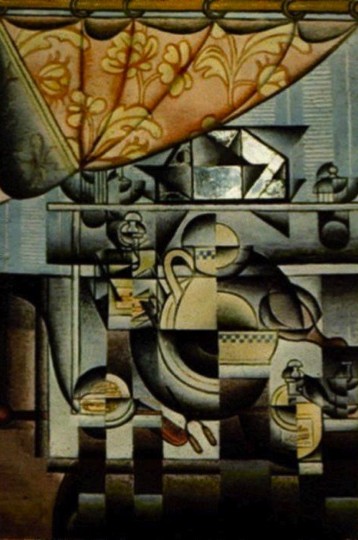
Like the apparatus that requires the observer to place him or herself in the doorway of the cathedral, the minimalist or literalist work creates a situation, oriented toward the presence of a beholder, which is completed by the presence of the beholder. Like the mirror image, one might say, the minimalist situation does not exist until someone occupies the situation it affords.2
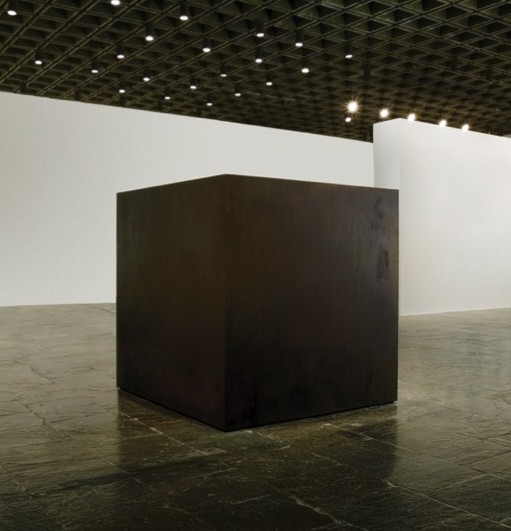
Further, and again like the mirror, on Damisch’s Lacanian account, it breaks the beholder into a seeing eye, on one hand, and a conjunction of surfaces, on the other, which the subject cannot fully reconcile with each other. Thus the apparatus forces the subject into a dialogue of perspectives and gazes (Damisch, 46-47). This subject sees and is to be seen. The work and the politics that succeed this development, this minimalist moment, only focus more insistently on making—or affording—the beholder a place, a position, a subject position, to use the official term. Hence the political dimension of much post-mimimalist work. More specifically, we are speaking of the politics of visibility, of identity. Think of Adrian Piper’s Hypothesis Series (1968-69), which combines a literal charting of the artist’s position in space with accounts of the experiences and identities of those she encounters.3

One might object that, like van Eyck’s mirror, Piper’s Hypothesis Series bore witness to her presence and did not specify a place for the beholder who reads and observes the documentation that present the work. But that would be to misunderstand the project. The Hypothesis Series, Piper explains, “acknowledges the perspectival character of human perception, by charting and documenting my navigation through space and time as myself a moving or stationary object with the capacity for sensory perception and the ability to self-consciously register those perspectival perceptions at fixed intervals. Thus the shift in perspective that characterizes this project implicitly introduces issues of subjectivity, personal identity, self-knowledge, self-objectification and difference.” Thus the representation she makes, of, say, the single mother who is her colleague and whose struggle with her Italian-American identity intrigues Piper, is meant, like Brunelleschi’s little picture of the baptistery, to give you an opportunity to match Piper’s representation against your own viewpoint. The proof of the pudding, so to speak, is still in the mirror.
The political alternative will emerge—paradoxically, given the similarity Damisch sees between van Eyck’s picture and Brunelleschi’s apparatus—from van Eyck’s picture. Its mirror is only a painted image, not a real mirror. Consequently, the mirror reflection in it is not a demonstration; rather, it makes or supports a claim, like an “affidavit,” at least on the reading (Panofsky’s reading) that Damisch engages. Certainly, the circumstances and subject of the painting are other than precisely as Panofsky understood them, and it is hardly my aim to support his reading. For the present purposes, it is enough that the signature be understood to attest to the presence the mirror evidences. “Jan van Eyck was here 1434” is the claim; the images in the painted mirror—presumably those of the artist and an unnamed companion—affirm its truth, rather then demonstrate it. They function like a signature, not a real mirror. And the juxtaposition and comparison to a signature are very much to the point. The image in the mirror, on this famous account, would need to show two figures because, as Damisch explains, legal protocol requires two, not one, to be present (Damisch, 130-31). And it does show two; a fact that is mirrored, so to speak, in another difference between van Eyck’s picture and Brunelleschi’s apparatus: the picture can bear witness to two or more beholders simultaneously. It is public. That is necessary because—as Panofsky argues—van Eyck’s picture functions legally; it emerges from and participates in civic life. In fact, Panofsky specifically points out that witnesses were not required for a valid marriage ceremony in the Church’s view. These witnesses were not the Church’s requirement, but the law’s.4 Thus the demonstration van Eyck’s mirror makes is specifically of the political realm, not the theological. And because its power derives from a claim—that Jan van Eyck and another legal subject bore witness for the Arnolfinis—and because its mirror image’s testimony is the same for everyone, regardless of who looks at the picture and where, the beholder’s position does not matter as it did for the user of Brunelleschi’s apparatus. In fact, as is the case for any legal document, once signed and executed among its parties and its witnesses and the proper authorities, the reader’s position—his subject position, her identity—does not matter at all. But, then, neither does what he or she sees. As Wlad Godzich explains, ancient Greece drew a distinction between those individuals who were qualified to bear witness, who constituted a theoria, and the population at large. Anyone might witness an event of political importance, but only a theoros had the authority to put “into socially acceptable and reliable language” what he saw.5 Hence, we are shown what van Eyck saw. What we see does not matter, has no authority. Godzich blames the demise of this system on philosophers, who “came along and attempted to ground everything in sense perception, in aesthesis” (Godzich, xv). Of course, by now, we have come to think of this—this refusal to submit our quest for truth to external authority—as a feature of modernity, and of freedom.6
So we have two modes of politics. One that depends on your subject position and one that doesn’t. And we have two kinds of art: one that depends on your subject position and one that doesn’t. And they align themselves, one with the other, according to what they assume about representation and about truth. Which kind of art is Miró’s? Or is it another kind altogether? And what kind of politics does it embody?
In the context of a recent exhibition devoted to the question of Miró’s politics, Robert Lubar explained nicely the difficulties the exhibition faced:
To chart Miró’s relationship with the changing tides of political Catalanism in these early years is a difficult undertaking. Although he was notoriously reluctant to declare a partisan position, his sympathies were undoubtedly on the left of the political spectrum, as his later commitment to the cause of the Spanish Republic demonstrates. His early letters are filled with enthusiasm for the international aspirations of Catalan culture, yet he repeatedly registered disdain for the political establishment and the willful ignorance of the recalcitrant bourgeoisie in his homeland.7
Or, similarly: “If political events and social movements were the engine behind his art—the very fact of his Catalan national sentiment unequivocally attests to this—that relationship was highly mediated” (Lubar, 37). Lubar goes on to see the ambiguous (but indubitable) presence of this Catalan national sentiment behind Miró’s Head of a Catalan Peasant series of 1924-25 (Lubar, 38).
Ultimately, Lubar proposes we describe the embodiment of Miró’s political position in terms borrowed from Jacques Rancière. Lubar cites a short passage from Rancière’s essay “Aesthetics as Politics” (which stemmed from a seminar held in Barcelona under the auspices of the Museu d’Art Contemporani) that deserves to be repeated here:
Art is not, in the first instance, political because of the messages and sentiments it conveys concerning the state of the world. Neither is it political because of the manner in which it might choose to represent society’s structures, or social groups, their conflicts or identities. It is political because of the very distance it takes with respect to these functions, because of the type of space and time that it institutes, and the manner in which it frames this time and peoples this space.8
Today, Rancière goes on to explain, we tend to see art fulfilling this political promise in two ways—“the two great politics of aesthetics: the politics of the becoming-life of art and the politics of the resistant form” (Rancière, 43-44). He clarifies:
The first identifies the forms of aesthetic experience with the forms of an other life. The finality it ascribes to art is to construct new forms of life in common, and hence to eliminate itself as a separate reality. The second, by contrast, encloses the political promise of aesthetic experience in art’s very separation, in the resistance of its form to every transformation into a form of life. (Rancière, 44)
So, the “politics of the becoming-life of art” finds its expression in “relational” work, in those projects that seek to shape a community for themselves or to break down the separation between art and life and transform life into something else by doing so. The latter, the “politics of the resistant form,” aims to resist becoming relational, to hold itself apart from ordinary life, to declare independence from ordinary life, and thereby envision something radically otherwise (Rancière, 22-24, for instance). Lubar aligns Miró’s art—with special emphasis on the early years that concern us here—with the “politics of the ‘resistant form’” (Lubar, 42). And it is in this mode, then, that his art is politically active.
Lubar would seem to align Miró’s work with the kind of politics the Arnolfini portrait exemplifies—in which your position doesn’t matter. But that is not exactly what his appeal to Rancière leads to. Lubar explains: “For Rancière both art and politics are involved in the distribution of ‘spaces and times, subjects and objects, the common and the singular’” (Lubar, 42; citing Rancière, 25). Or, as Rancière also puts it, art and politics are “linked, beneath themselves, as forms of presence of singular bodies in a specific space and time” (Rancière, 26).
This thesis, which is tangent to arguments Rancière makes elsewhere, is open to some criticism.9 For my purposes in this argument, it is enough to say that I want to question Rancière’s claim that the “aesthetic regime of art” fulfills its political potential only as an “autonomous form of experience,” as a “form of sensory experience” (Rancière, 32). This claim grows out of a desire to reorient a (modernist) concern with the autonomy of the artwork away from the context of its making and toward the context of its actual or empirical place in common experience. I will claim that it is the achievement and the political importance of Miró’s art of these years to reveal the limitations of the “sensory experience” of a situated beholder. In what follows, I will build on the paradigms of perspective I have introduced with the help of Damisch to test the hypothesis that a description of Miró’s own mode of perspective will give us an account of his kind of politics. Ultimately, I shall try to show, Miró’s work (at least in the period I consider) addresses itself to a beholder who occupies a position—which is to say that it shapes a space, as Rancière might put it—, only to show that beholder that no position is adequate to the task of seeing the work of art.

Let’s begin early in Miró’s career, with his 1918 Nude with Mirror. I’ll point out three things about the picture that I consider especially important. First, Miró has rendered the pattern in the rug and on the side of the hassock so as to undermine or negate an effect of recession into depth. The ground plane tips up, and the hassock flattens out, parallel to the picture plane. Secondly, a loop of drapery, cubified awkwardly, slightly but pointedly overlaps the figure’s shoulder. This effect seems to me to qualify that of the flattening in the rug and hassock, since the overlapping creates at least the logic of depth and draws the figure into it. Thirdly, the figure turns the hand mirror, understandably enough, away from the beholder and toward herself. Given the context into which I’ve inserted Miró—alongside Brunelleschi and van Eyck—the mirror seems important. But, and this strikes me as another strongly marked choice of Miró’s, the nude figure’s face does anything but imply that she looks at the mirror. This curious choice joins the loop of cubified curtain in causing, I want to say, the space to close up or even to turn in on itself. That’s what a mirror does: turn space back to face itself. But unlike either Brunelleschi’s mirror or van Eyck’s, this mirror faces away from the beholder, and turns space away from that beholder. The figure’s lowered eyelids then render its demonstration moot.
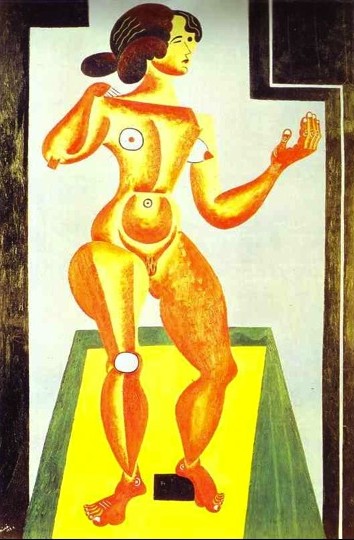
This 1921 Standing Nude invites parallel observations. The space is once again flattened, by the anti-perspectival rendering of the proscenium the figure stands on and by the flat black frame that encloses her. But her figure is rendered in a quirky combination of representational modes that includes effects of volume. Her right arm is clearly modelled, for instance. Further, it implies and as it were embraces a certain deep space insofar as it points outward and folds back on itself. This isn’t the deep space of perspectival projection that opens up a void in which to dispose bodies, but a more intimately physical space, which is opened up by a body and which ends at the limits of that body’s reach. In several ways, the figure confirms my hypothesis. For example, right where the hand should be, a set of lines like rays emerge from the figure’s wrist and disappear behind her shoulder. It’s as if the figure’s volume were to be measured in the distance that elbow pressed forward and outward from the graphic space just behind her shoulder, the space to which her body returns where her hand vanishes. The figure’s other hand is no less remarkable or important. She holds it out in front of her—again, extending the body’s space outward—and turns her hand back toward herself, differently from the way the figure’s right hand does, but to analogous effect; that is, turning the hand back on itself closes or encloses the space the body claims. In fact, because she holds the hand out from herself and because she ambiguously appears to look at it, I want to compare it to the hand in the earlier Seated Nude that holds the hand mirror.
I would also point out another feature of this hand—specifically, that it is evidently a right hand. So maybe one would say it is in some sense a mirror image, reversed to face the figure in the painting. Or, one might rather say that there is a sense in which the figure itself should be thought of as both facing outward and as turning around, into the picture. Fundamentally, the two possibilities aren’t so different. Either way, the figure faces out of the picture and turns into the picture, too. Obviously, as an account of the picture’s mode of perspectival projection, this raises more questions than it answers. Perhaps we should understand it, as we have understood the mirrors we’ve seen elsewhere, to register the presence of a space outside the picture (such as that in which van Eyck and his companion stood or that in which the holder of Brunelleschi’s apparatus stood) to the scene pictured in it.
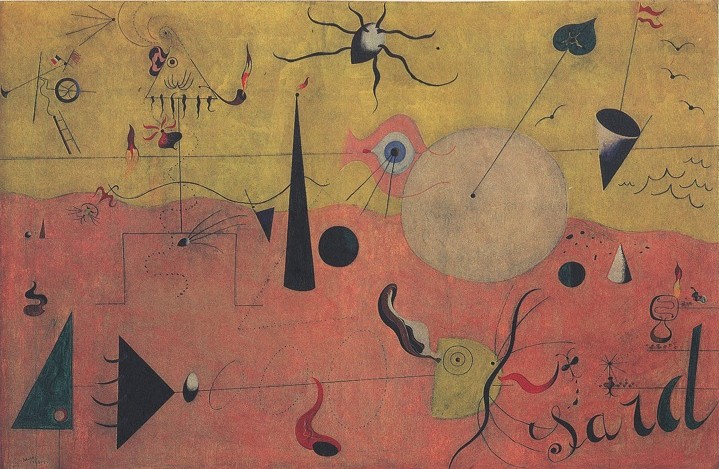
The central figure of Catalan Landscape of about two years later can be understood similarly. I see it as an important instance of Miró transforming an early motif—in this case, the figure that faces outward and inward simultaneously—as his larger pictorial strategies change.10 The figure of the hunter faces out of the picture, but his hat does something I want to claim orients it into the picture, in something like the way the reversed hand mirror can be thought of as orienting the reflected face of the seated nude into the picture. I say that because the hat is connected to, tangent to and repeated in spectral bands, which lead in turn to a passing comet. In fact, the crown of the hunter’s hat is dotted, like the bands that emanate from it to touch the comet, as if to underscore their identity against the obvious differences between a hat and atmospheric or celestial phenomena. But that very distinction—between the near and the far—is precisely what Miró seems to have been determined to elide.
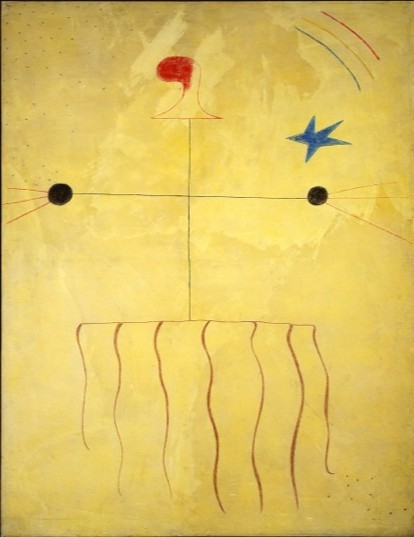
Other works of the 1920s develop this theme, too. The National Gallery of Art’s own Head of a Catalan Peasant of 1924, for instance, centers on a figure reduced to little more than the cross-axial lines and barretina we saw in the hunter-figure in Catalan Landscape. Just beside the figure, a set of colored lines denotes a rainbow, while a star comes almost to settle on the figure’s left cross-member. In 1972, Rosalind Krauss offered a reading of the lines of such schematic cross-axial figures, one component of which centrally concerns us here: her suggestion that the horizontal cross-member, which we can read as the arms of a stick figure, can also be read as the horizon that defines the limit of deep pictorial space, Miró’s way of uniting the near to the far, the space of the body to the vastness of earth and sky.11 Thus I want to point to the curving crown of the barretina to note that it is colored in, as if to mark, albeit in a different way from the one we saw in Catalan Landscape, the hat’s changing status as it passes from contact with the body to a silhouette projected against the sky.
Finally, note the two constellations of dots—one in the upper left corner of the picture and one in the lower right. They are very small and difficult to see in reproduction. In fact, in reproduction it is virtually impossible to see that, in making the dots, Miró has pierced the canvas in the lower right quadrant. Perhaps it is his way of making literal or, so to speak, sculptural, the effect the picture most forcefully evokes, at least in my mind: the effect of rendering available to vision the transition from the physically immediate to a separate space, some kind of beyond.
Of course, to see those little holes it’s actually necessary to get pretty close to the canvas and look carefully. The same kind of close inspection seems like the right way to approach the small dots in the upper left of the canvas, as well. And I don’t think this is a trivial fact about them. As is widely noted, Miró spoke as early as 1918 to his friend J.F. Ràfols of his
Joy [as Miró put it] at learning to understand a tiny blade of grass in a landscape. Why belittle it?—a blade of grass is as enchanting as a tree or a mountain.—Apart from the primitives and the Japanese, almost everyone overlooks this which is so divine.—Everyone looks for and paints only the huge masses of trees, of mountains, without hearing the music of blades of grass and little flowers and without paying attention to the tiny pebbles of a ravine—enchanting.12
This early passage does more than show Miró’s awareness of the mesmerizing power a small pictorial element can wield. It also connects these small details with the scale and distances of landscape—with mountains and ravines—, rather than with still lifes and portraits. In other words, Miró puts his fascination with the small in such a way as to make it clearly part of his relation to the vastness of space in general. In fact, there are two sides to this fascination, I think. On one hand, there’s the more explicit sense in which Miró expresses an attraction to small things in the vast world. On the other hand, though, there’s another sense in which the small details seems to have to do with the scale of painting (painting as he practices it, which is to say, easel painting). The brute quality of the little marks Miró makes on the surface of this painting work, by resisting easy assimilation to the fictional world of the peasant figure, to keep both their senses—that is, both their role as tiny points in the yellow world of the Catalan peasant and their character as marks on the painted surface—aggressively in view. And as I’ve said, this goes double for the holes he pokes in the canvas.
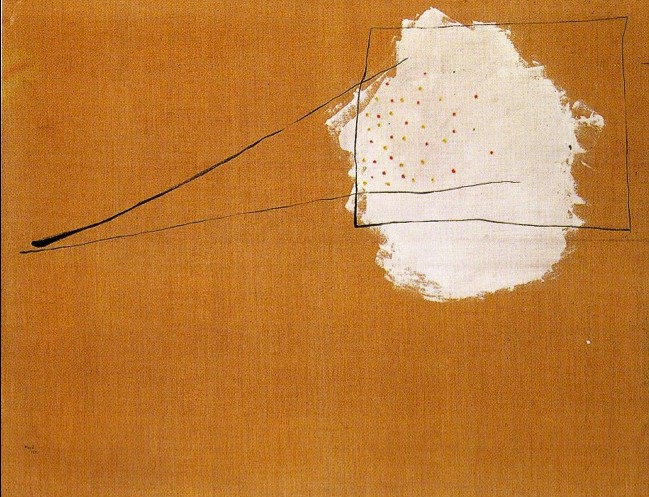
That fascination with vastness, which I’m claiming is bound up with Miró’s attention to the minute, appears again later as a theme when Miró writes to Pierre Loeb, for instance, of his desire to “have loving relations, so to speak, with my earth, to lie on the sand and lick this beautiful sky.”13 It is also a leitmotif of later work. In the 1927 canvas titled only Painting, Miró shows more dots—red mixed with yellow, this time—scattered on a white patch that mostly corresponds to the area of a roughly drawn rectangle. The rectangle itself is transfixed by two rays emanating from near the left edge of the canvas. Altogether, the scene resembles nothing more closely than it does the famous pyramid of Albertian perspective, unless it is taken to resemble projection in a cinema. So again, the little points Miró renders assume their place in a model of beholding, one which we could call generically by the name “projection,” and in which the subject looks into a scene that has a sort of directionality—a scene that is, as the word “projection” implies, thrown forth, away from him. One way to read the picture, then, is as a sort of illustration of the image as projection. Taken in a large sense of projection, that could be about the way an easel painting can picture vastness as a kind of recession or projection away from the beholder—as in perspectival projection. The dots, then, would once again be playing their old role as markers of vast or even celestial distance—like stars in the sky. Further, since Miró has opposed this projected scene to his characteristically tiny signature, the latter strikes me as doing double service in the picture: as the position of the beholder in the diagram of beholding, tiny before the projected vastness; but on the other hand, also keying the actual beholder in to an opposition of scale between the signature, which is, after all, understandable as a feature of the painting rather than of the fictional world it pictures, and the painting’s size—an opposition that invites the beholder to come close, or at least to imagine doing so, and to register the relative vastness of the framed expanse of the canvas.
Now, as Félix Fanès has recently emphasized, Miró’s references to popular and particularly cinematic culture toward the end of the 1920s owe much to his association with Michel Leiris and the circle around the dissident-surrealist journal Documents.14 That journal was published in 1929 and 1930, but Leiris’s association with Miró goes back to 1922, and Leiris’s interest in motion pictures, and in projection generally, dates to around the same time.
In fact, the first reference Leiris makes to the experience of cinema in his private journal is an account of a dream, rather than a note on an actual motion picture viewing. In the dream Leiris recorded the sixteenth of March, 1923, he describes himself, dead, looking at a sky filled with dust “like,” as he puts it, “a theater outside the projector’s ray.” He continues:
Many luminous globes, of a milky white, were lined up in the depths of the sky; from each of them came a long metallic wire, and one of them pierced my chest through without my feeling anything but a great beatitude. I advanced toward the globes of light by sliding along the length of the wire, and I held the hands of other men who rose like me toward the sky, each following the rail that perforated his flesh. One heard no noise but the light squealing of the steel on our chests.15
To paraphrase Leiris a little: one might say the dream takes projection as a model of space, then turns it into a story about being projected into celestial space, to feel one’s distance from it collapse. That image is not far at all from the experiments Miró began in 1923 with Catalan Landscape, and it’s closer still to the story we might tell about the 1927 painting on sized canvas and its scene of projection.
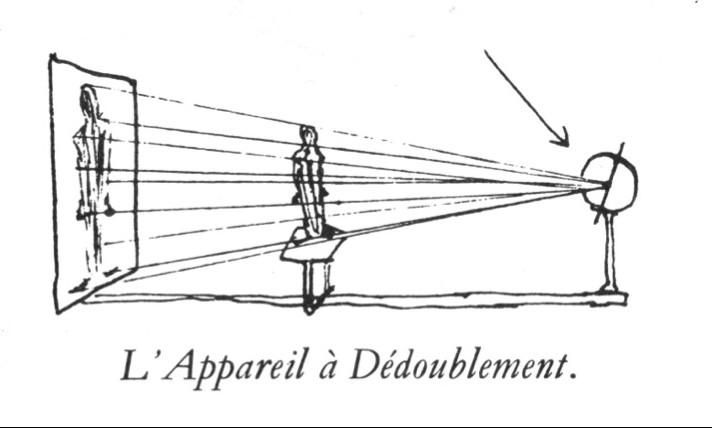
The following year, Leiris wrote a related journal entry—this one apparently inspired by a visit to the Musée des Arts et Métiers. On his visit to the museum, Leiris had seen a “device for learning the use of perspective” (Leiris, entry for October 15, 1924, 70-71). In the journal entry for the following day, Leiris turns this apparatus into a fanciful invention of his own, which he calls “The Doubling Machine” (“L’Appareil à Dédoublement”). He illustrates the machine with a diagram and an explanatory legend: “Generative sphere of medullary rays, owing to the obliqueness of the infra-cosmic mirror. The subject, projected into a frame with the weight of his matter, inscribes his double there enlarged and with independent existence” (Leiris, entry for October 16, 1924, 71).
Leiris’s thought experiment underscores the intimate connection of projection to scale—and especially to the scale of the sky or the cosmos. One of the themes Leiris develops at length later, in his writings for Documents, is that of the relation of the individual, embodied self to the cosmos, as microcosm and macrocosm.16 That is a much better-known story, so I will just note it and pass over it here, because I want to return to Miró, but I think it’s important to note two things: first, the way Miró represents the relation of the body to the cosmos can be understood as a kind of perspective—as implying a kind of projection. And second, the way Miró represents that relation changes around this time—around 1929 and 1930. He begins to place less emphasis on metaphors or symbols, and to place greater weight on the literal correspondences between the beholder’s experience of the picture and experience in general.

I take this to be a crucial transition, because it relates Miró’s art to a drive among certain members of the Documents circle toward more literal, which is to say, less metaphorical, effects.17 In 1929 Leiris said Miró had left behind his “small equations,” such as, “sun=potato, slug=small bird, gentleman=moustache, spider=sex, man=soles of the feet.”18 As an example of the new turn in Miró’s art, Leiris refers to “the bedroom of the queen of Prussia,” the bareness of which he says is simple to understand: “the furniture has dissolved in water, the way my table does sometimes, when I’m tired and my books and cigarettes turn out to be incapable of beguiling my boredom” (Leiris 1929, 28). That is, Leiris connects the bareness of Miró’s special kind of pictorial space very directly to a certain mode of ordinary experience. He elaborates on the thought:
It is Miró who has expressed this liquefaction, this relentless evaporation of structures—as relentless as any of the other vicious circles in which I, and all of creation, turn round and round—this soft leakage of the substance that makes all things—us, our thoughts, and the setting we live in—like jellyfish or octopi; he has been the one to express this so satisfactorily in several of his old canvases and especially in his current series of Portraits. (Leiris 1929, 29)
To Leiris’s point about the Queen Louise of Prussia, I’d like to add an observation or two that will build on themes he and I have already proposed. First, I would like to note that the figure’s arms are based on an advertisement for shirt collars,19 and that Miró’s attraction to the form of the shirt collar owed at least something to the fact that it turns over on itself, with a tie that crosses like folded arms.
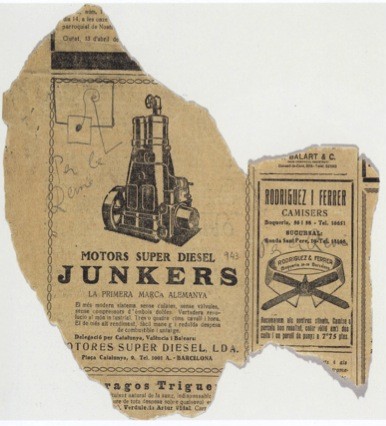
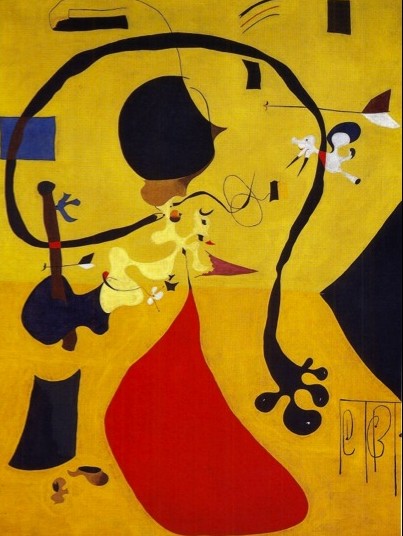
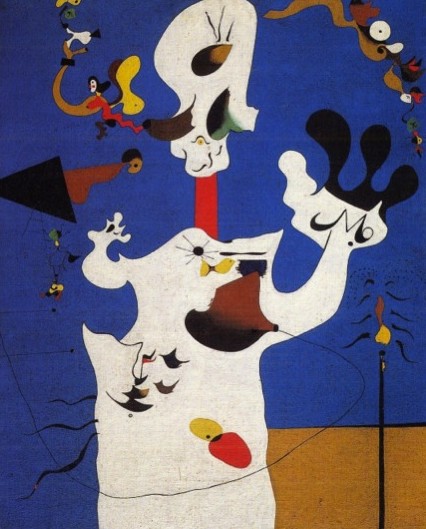
Like the folded-over arm of the 1921 Standing Nude, I take the arms crossing each other or crossing the figure’s body to be a way of letting the body define its space by embracing it. Another version of this strategy would be that of Miró’s 1928 Dutch Interior in the Metropolitan Museum of Art, in which the arm, rather than cross over the body, travels around it in a giant arc, to unite an outward-facing pose to a turning figure. In The Potato, which shares preparatory drawings with the reaching arm of the Met’s Dutch Interior, a drawn line replaces most of the arc of the right arm; meanwhile the figure’s right hand has apparently migrated to its left arm. The hand at the end of the left arm is, evidently, a right hand, with its palm facing away from us. The migrating right hand brings us full circle, so to speak, back to the Standing Nude.
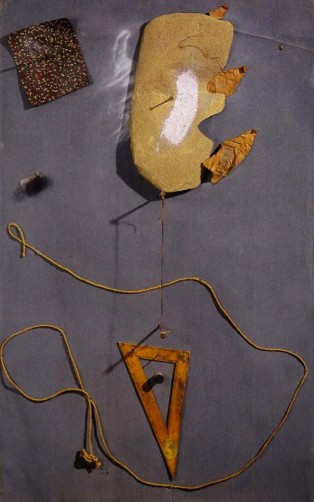
A 1928 collage titled Spanish Dancer combines several of these techniques for rendering and condensing gesture and bodily volume. As Anne Umland observed to me, the figure is organized like the cross-axial figures, which may be taken to imply, as we’ve seen, a double relation between the figure and its space. Similarly, Rémi Labrusse has discussed the relation of Miró’s dancer theme to ecstatic identification with the not-self in a short essay on Miró’s Spanish dancers.20 In this Spanish Dancer, the string that hangs in the middle of the assemblage, and which originally dangled at the bottom, with the lower nail loose like a plumb bob, is something like the vertical that establishes the figure’s upright posture.21 The loose string, though, would also evoke the possibility of its rotation. That is, the possibility of the figure turning, like a dancer. I take that turning, and possibly the arms of the spinning figure, as well, to be summarized in the loop of string that circles the lower half of the figure, which renders the movement once again as a contour that contains the figure.22 The opposition contained in the string’s dual nature—the opposition between it as an object set over against the beholder, on one hand, and as a turning into and a turning-to-face-into the deep space of the fictional world—that opposition represents the impossible pair of relations I have been finding throughout Miró’s works. To return that opposition to our larger question: If the contradictory relations the works project for the beholder rule out the Brunelleschian mode, so to speak, of political engagement via subject position, and the specificity of those relations rule out the universal address of what we might call the van Eyckian mode, then Miró’s works must demand a different accounting. If we continue to trace this opposition, we may be able to supply that account.
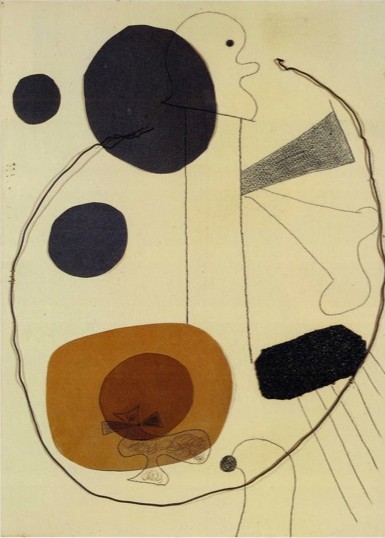
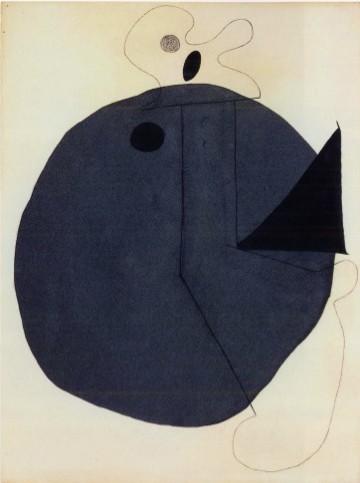
A pair of collages from 1929 forcefully demonstrates the two senses of the loop. Each composition centers on a figure—the shape of their heads clearly connect them to the Spanish Dancer as well as to The Potato. The body of each is a vertical band, like the vertical lines of the cross-axial figures that run through the works of the 1920s. In one of the 1929 collages, though, a loop of wire circles the figure like the string that loops around the 1928 Spanish Dancer or the line that emerges from The Potato’s volcano-breast to reach around its figure. The other 1929 collage is close in composition to the first, but in place of its wire loop, a rough disk of flocked paper is collaged to the drawing, creating a translucent circular space for the figure. It’s as if Miró has reinterpreted the same shape as both the gesture of the figure’s arm and as the contour of a volume that defines or contains the space that gesture claims for the figure.
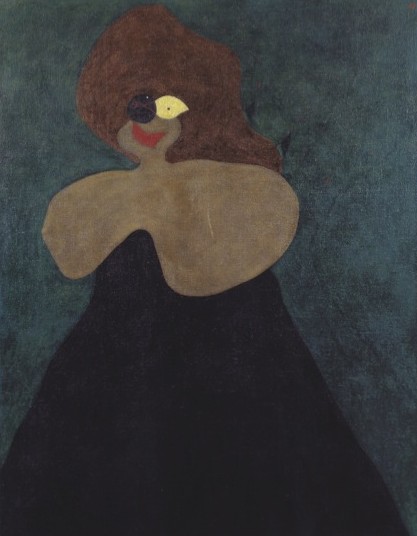
Now consider Miró’s Portrait of La Fornarina.23 The upper right-hand corner of Miró’s painting reveals, on close inspection, about eight red dots, which float more or less visibily between the figure and the corner of the painting. As in the examples we saw earlier, I want to align these dots with projection into the picture, with extension into deep space. Furthermore, I want to emphasize in this case more than in the others, that seeing the dots requires a close examination and an intensity of looking that is considerably greater even than the Head of a Catalan Peasant in Washington requires.24 Seeing all eight dots means standing close and looking hard.25
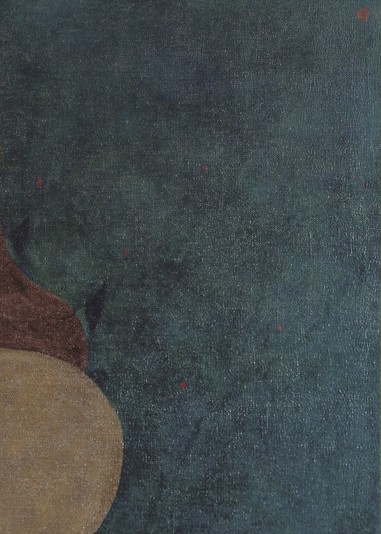
But doing that puts one, it seems to me, at something closer than a natural viewing distance to the roughly trapezoidal blackish shape in the lower half of the canvas. That is to say, taking that dark form in as a distinct shape while straining into the picture to see the red dots strikes me as nearly impossible. From close-to, that dark area becomes a formless void, a blind spot that withdraws the lower part of the figure and of the painting from peripheral vision. I don’t feel this is an accident. Rather, I feel in this precisely an echo of Leiris’s remark that the objects in the space of Queen Louise’s bedroom have “dissolved in water, the way my table does sometimes” (Leiris 1929, 28). Leiris sees the ability to express this dissolution, this “liquefaction, this relentless evaporation of structure,” as Miró’s special achievement, particularly in the Imaginary Portraits (Leiris 1929, 28-29). In places like this, Miró seems to excel in converting pictorial space into an equivalent for an internal or bodily space, which has no distinct objects in the way the objective space that spreads out before us does. Of course, the boundaries of that bodily space—its horizons, one might say—are not clearly defined. Catalan Landscape teaches that lesson by representing as gradual rather than abrupt the transitions from the hunter’s head to his barretina to the rainbow to the comet. The difference—or, a key difference—between Catalan Landscape and Portrait of La Fornarina is exactly that that lesson goes from being illustrated by a metaphor—recall Leiris’s list of neat equations that fall out of Miró’s work—to being demonstrated, in a much more literal way, by the conditions of viewing the painting itself stages. Looking at Miró’s Portrait of La Fornarina produces and relates to each other the experiences of straining at small things and losing oneself in the painting’s space.
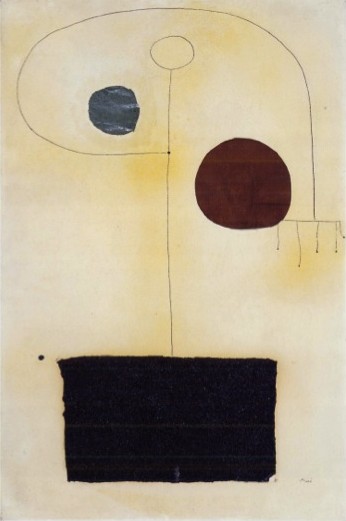

Another 1929 single-figure composition reduces, or distills, the themes I’ve been discussing and condenses the turning with the projection I discussed earlier (plate 32). The composition is clearly a stripped-down revision of the turning figure we saw before in the Dutch Interior. This one is based on a drawing, which it closely resembles in composition (F.J.M. 2588, MoMA 2008, page 73, fig. 3). Another drawing, which shows an array of five dots that correspond to the dots at the end of the first drawing’s fingers, and which were apparently generated by the impressions Miró’s left in drawing the figure’s dotted fingertips, suspends them in the sky (I say that because they’re above what I take to be a horizon line), like the projected points we saw earlier. That transformation makes explicit—perhaps literal would be a better word—the comparison between the finger-tip limit of the body that embraces its own space and the projection that throws tiny dots into the vastness of celestial distance.
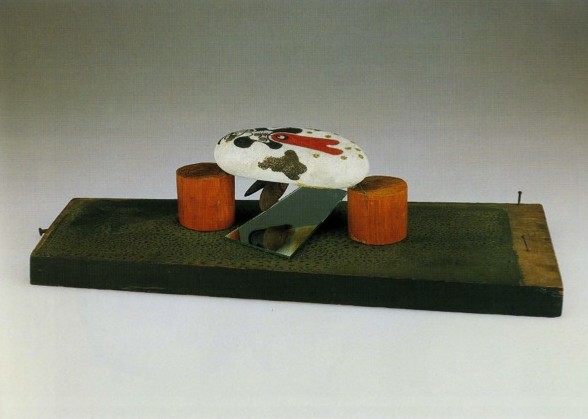
Let me close with one more example, taken from a couple of years later than the works we’ve considered so far. It’s the 1932 Object in the A.E. Gallatin Collection at the Philadelphia Museum of Art. In his recent discussion of this work and this period in Miró’s oeuvre, William Jeffett reveals an emphasis among contemporary commentators on various ways the corporeal presence or literal size of the beholder come into play. Miró’s friend Ràfols referred to works of this period as “corporeal realizations”; Estratios Tériade glossed their toy-like quality in terms of “big people or . . . children who have grown up [qui ont grandi] in us”; George Hugnet says these objects are bereft of fetishism, but that their “symbols grow in size,” and further that they work as ideograms or “correspondences,” so that there “are no more comparisons and metaphors.”26 Like Jeffett, I take these acknowledgements of the role of size and of the beholder’s own corporeality and the beholder’s size seriously. Moreover, as I said earlier, I take Miró’s disjunctions of scale to be his own way of implying projection—as if the children who have grown up in us are seeing themselves projected in us at some distance, as if by the medullary rays of Leiris’s fanciful machine for doubling.
Indeed, the 1932 Object feels small, pointedly or emphatically small—it’s less than six inches tall—, at least partly because it represents a figure against a field of sequins as the small points I’ve taken elsewhere to represent celestial motifs, like stars, projected into the vastness of space. To see this work properly, one must get up close, as with Miró’s Portrait of La Fornarina. Its smallness works, like that of Miró’s tiny signature in the 1927 Picture we saw earlier, to create “correspondences,” to borrow Hugnet’s word, albeit inverted ones, between the beholder’s closeness and the vastness of the cosmic setting in which the figure of the ballerina appears (Jeffett, 88 and F.J.M. 1447a). Beneath the stone, the mirror, which as Miró’s note on his preparatory drawing indicates, allows one to “see in all directions and in all forms [or ways (formes)]” (F.J.M. 1447a)—returns to the theme Miró opened in his Nude with Mirror almost fifteen years earlier. The difference, though, would be that, rather than represent the pictorial space as folded over or projected back over the turning figure, Miró turns the projection outward. Thus, Miró uses the mirror to displace the beholder’s point of view quite literally into the work. Or, Miró displaces one point of view for the beholder into the work via the mirror. He leaves another, equally important point of view outside, close to the upper surface of the stone, straining into celestial distance. In this, I see the literal turn accomplished—the turn away from the metaphors and simple equations to which Leiris and Hugnet referred. Rather than represent a figure or a space that both faces us and turns away to continue our space into its fictional distance, the 1932 object invites us close up to face the figure and gaze into space but also to occupy a position within it, between its legs, as it were, from which to see outward.
This is unlike Brunelleschi’s mirror, which determined a position for its subject, in order to perform its demonstration and establish its univocal truth. It is also unlike the witness of van Eyck’s painted mirror, which affirmed van Eyck’s position for anyone, anywhere to see. Miró’s perspective establishes two relations for the subject to the world in the work of art—two incompatible positions. Miró offers a double perspective, a twinned relation—two positions: one within the space and one at a distance. Like the point of view of the child grown up in us, it is our own and also one from which we are distanced. This double perspective cannot be reduced to the constructed situations of Brunelleschi or of minimalism or of Piper, the art of the subject position. Nor does it offer the objective witness of Panofsky’s van Eyck, left to depend, in the absence of demonstration, on what Jacques Derrida called “effects of signature” cut off from the demonstration of presence Brunelleschi’s mirror affords (Derrida, 20).27 Rather, Miró’s object with its mirror demonstrates the fact of and the inadequacy of presence, the insufficiency of your—or anyone’s—subject position, to the task of seeing, where seeing is taken to mean understanding a world, such as the fictional world Miró offers. Miro’s object likewise holds out the possibility that, if we will let go of both political projects—demonstrating the presence of the subject and bearing witness to the presence of the authority—we may find we see the world together after all. Perhaps this means we would be wrong to see Miró’s politics in his attachment to Catalan identity. Perhaps the right approach would be something more like acknowledging Miró’s embrace of Catalan identity and his paradoxical insistence that intelligibility, such as paintings or any object of shared understanding requires, depends on transcending one’s subject position. Perhaps this is what Damisch had in mind when he called surrealism’s own mode of perspective utopian (Damisch, 264-66). Perhaps Miró’s is the politics of nowhere.
Notes
Filippo Brunelleschi built a perspective device that combined a rendering of the Florence baptistery with a mirror. Its story is one of the origin myths of the art and science of perspectival projection—of what the Florentine renaissance called costruzzione leggitima. Brunelleschi painted a small picture of the Florentine baptistery, which is located directly opposite the entrance of the Florentine cathedral. This picture and the accompanying apparatus were to provide a demonstration of a new technique, which we now call perspective. But Brunelleschi wanted his picture not just to show this technique, but also to demonstrate its accuracy, its special ability to put objects in space and in correct relation to one another. So he provided the beholder an apparatus that would permit each beholder to demonstrate to himself the validity of Brunelleschi’s technique.
Brunelleschi drilled a small hole in the painted panel, so the beholder could look through the hole at the mirror and see the perspective construction in the mirror. The apparatus, including the painting and the mirror, was small, which allowed the beholder to hold it easily, and even to hold it at the very place—a point three braccia inside the door of the Florentine cathedral opposite the baptistery—from which the view was projected (fig. 1).

Now, regardless of where the picture was seen, it would have offered a convincing likeness of the baptistery. Furthermore, the mirror might have enhanced the beholder’s experience of the panel’s verisimilitude, regardless of where this device might have been used. But, used at precisely the right place, just inside the doors of the cathedral, it would have done something crucially different. Restricted to a single eye’s point of view and aided by the mirror, the beholder could have judged the conformity of the image in the painting to the view of the baptistery available from that privileged point of view. The picture was an example of the new technique of perspectival projection; the apparatus was a device for proving the technique’s claim.
In his discussion of this device, Hubert Damisch aligns the painting with “showing” and the mirror with “demonstrating.”1 The painting shows the baptistery and some part of the surrounding square. The mirror, on the other hand, makes nothing new visible. It only shows the painted scene in relation to the real place. Rather than offer a new prospect, it does something called demonstrating, which Damisch understands in the sense of demonstrating the truth of a theorem or the guilt or innocence of an accused person. The mirror establishes the truth of the painting’s claim. But, and this is a crucial point, it can only do so for a single eye that occupies a particular point, which is determined rigorously by the perspectival projection. Perhaps it is worth noting that Brunelleschi’s device is constructed in terms of the user’s body, and specifically in terms of braccia—a measure derived from the length of the forearm. Thus, the panel is just over half a braccia square. The mirror is to be held at an arm’s length—at one braccia—and at a point precisely three braccia inside the door of the cathedral. It is as if Brunelleschi’s apparatus were a machine for extending a rationalized abstraction of the human arm throughout the modules of a grid that carried to infinity the body of the beholder.
Damisch compares the function of the mirror in Brunelleschi’s apparatus with the mirror in Jan van Eyck’s Arnolfini picture (Damisch, 129-31). Referring to Erwin Panofsky’s thesis that the picture fulfills the function of a legal document, Damisch points to the famous signature—“Jan van Eyck was here”—and its conjunction with the mirror as something similar to the evidentiary structure in Brunelleschi’s apparatus. Both locate the subject at a precise position and do so for the more or less literally legal purpose of demonstrating their relation to a place, to a situation. Of course, in this, it is also unlike Brunelleschi’s apparatus, since one needn’t maintain a specified position. I think this is significant, so I will return to it presently.

First, let us ask: How will all of this help us understand Joan Miró’s politics? He did not use costruzzione leggitima or anything much like it. Few modernists did. Nevertheless, Damisch heaps scorn on the idea that perspective’s reign ended in modernism (Damisch, 35ff). This is part of his general rethinking of the notion of perspective’s history as a trajectory from origin to demise. Rather than ask whether this age or that culture used perspective, he asks instead what perspective they had (Damisch, 12-13). Accordingly, to take one example, he recuperates the multiple viewpoints of post-Cézannian painting for an enlarged notion of perspective by invoking a collection of miniature cones of vision, each cast eccentrically like a glance or a stare from a mobile subject (Damisch, 35-37) (figs. 2 and 3). But this continuation of perspective leaves aside the question of the mirror—of the literal mirror, of Brunelleschi’s mirror. The regime, as it were, of Brunelleschi’s demonstration surely has a history of its own in modernism. Perhaps Juan Gris’s Le Lavabo, with its fragment of mirror, could be seen this way. But without doubt, Brunelleschi’s apparatus continues itself in minimalism.


Like the apparatus that requires the observer to place him or herself in the doorway of the cathedral, the minimalist or literalist work creates a situation, oriented toward the presence of a beholder, which is completed by the presence of the beholder. Like the mirror image, one might say, the minimalist situation does not exist until someone occupies the situation it affords.2

Further, and again like the mirror, on Damisch’s Lacanian account, it breaks the beholder into a seeing eye, on one hand, and a conjunction of surfaces, on the other, which the subject cannot fully reconcile with each other. Thus the apparatus forces the subject into a dialogue of perspectives and gazes (Damisch, 46-47). This subject sees and is to be seen. The work and the politics that succeed this development, this minimalist moment, only focus more insistently on making—or affording—the beholder a place, a position, a subject position, to use the official term. Hence the political dimension of much post-mimimalist work. More specifically, we are speaking of the politics of visibility, of identity. Think of Adrian Piper’s Hypothesis Series (1968-69), which combines a literal charting of the artist’s position in space with accounts of the experiences and identities of those she encounters.3

One might object that, like van Eyck’s mirror, Piper’s Hypothesis Series bore witness to her presence and did not specify a place for the beholder who reads and observes the documentation that present the work. But that would be to misunderstand the project. The Hypothesis Series, Piper explains, “acknowledges the perspectival character of human perception, by charting and documenting my navigation through space and time as myself a moving or stationary object with the capacity for sensory perception and the ability to self-consciously register those perspectival perceptions at fixed intervals. Thus the shift in perspective that characterizes this project implicitly introduces issues of subjectivity, personal identity, self-knowledge, self-objectification and difference.” Thus the representation she makes, of, say, the single mother who is her colleague and whose struggle with her Italian-American identity intrigues Piper, is meant, like Brunelleschi’s little picture of the baptistery, to give you an opportunity to match Piper’s representation against your own viewpoint. The proof of the pudding, so to speak, is still in the mirror.
The political alternative will emerge—paradoxically, given the similarity Damisch sees between van Eyck’s picture and Brunelleschi’s apparatus—from van Eyck’s picture. Its mirror is only a painted image, not a real mirror. Consequently, the mirror reflection in it is not a demonstration; rather, it makes or supports a claim, like an “affidavit,” at least on the reading (Panofsky’s reading) that Damisch engages. Certainly, the circumstances and subject of the painting are other than precisely as Panofsky understood them, and it is hardly my aim to support his reading. For the present purposes, it is enough that the signature be understood to attest to the presence the mirror evidences. “Jan van Eyck was here 1434” is the claim; the images in the painted mirror—presumably those of the artist and an unnamed companion—affirm its truth, rather then demonstrate it. They function like a signature, not a real mirror. And the juxtaposition and comparison to a signature are very much to the point. The image in the mirror, on this famous account, would need to show two figures because, as Damisch explains, legal protocol requires two, not one, to be present (Damisch, 130-31). And it does show two; a fact that is mirrored, so to speak, in another difference between van Eyck’s picture and Brunelleschi’s apparatus: the picture can bear witness to two or more beholders simultaneously. It is public. That is necessary because—as Panofsky argues—van Eyck’s picture functions legally; it emerges from and participates in civic life. In fact, Panofsky specifically points out that witnesses were not required for a valid marriage ceremony in the Church’s view. These witnesses were not the Church’s requirement, but the law’s.4 Thus the demonstration van Eyck’s mirror makes is specifically of the political realm, not the theological. And because its power derives from a claim—that Jan van Eyck and another legal subject bore witness for the Arnolfinis—and because its mirror image’s testimony is the same for everyone, regardless of who looks at the picture and where, the beholder’s position does not matter as it did for the user of Brunelleschi’s apparatus. In fact, as is the case for any legal document, once signed and executed among its parties and its witnesses and the proper authorities, the reader’s position—his subject position, her identity—does not matter at all. But, then, neither does what he or she sees. As Wlad Godzich explains, ancient Greece drew a distinction between those individuals who were qualified to bear witness, who constituted a theoria, and the population at large. Anyone might witness an event of political importance, but only a theoros had the authority to put “into socially acceptable and reliable language” what he saw.5 Hence, we are shown what van Eyck saw. What we see does not matter, has no authority. Godzich blames the demise of this system on philosophers, who “came along and attempted to ground everything in sense perception, in aesthesis” (Godzich, xv). Of course, by now, we have come to think of this—this refusal to submit our quest for truth to external authority—as a feature of modernity, and of freedom.6
So we have two modes of politics. One that depends on your subject position and one that doesn’t. And we have two kinds of art: one that depends on your subject position and one that doesn’t. And they align themselves, one with the other, according to what they assume about representation and about truth. Which kind of art is Miró’s? Or is it another kind altogether? And what kind of politics does it embody?
In the context of a recent exhibition devoted to the question of Miró’s politics, Robert Lubar explained nicely the difficulties the exhibition faced:
To chart Miró’s relationship with the changing tides of political Catalanism in these early years is a difficult undertaking. Although he was notoriously reluctant to declare a partisan position, his sympathies were undoubtedly on the left of the political spectrum, as his later commitment to the cause of the Spanish Republic demonstrates. His early letters are filled with enthusiasm for the international aspirations of Catalan culture, yet he repeatedly registered disdain for the political establishment and the willful ignorance of the recalcitrant bourgeoisie in his homeland.7
Or, similarly: “If political events and social movements were the engine behind his art—the very fact of his Catalan national sentiment unequivocally attests to this—that relationship was highly mediated” (Lubar, 37). Lubar goes on to see the ambiguous (but indubitable) presence of this Catalan national sentiment behind Miró’s Head of a Catalan Peasant series of 1924-25 (Lubar, 38).
Ultimately, Lubar proposes we describe the embodiment of Miró’s political position in terms borrowed from Jacques Rancière. Lubar cites a short passage from Rancière’s essay “Aesthetics as Politics” (which stemmed from a seminar held in Barcelona under the auspices of the Museu d’Art Contemporani) that deserves to be repeated here:
Art is not, in the first instance, political because of the messages and sentiments it conveys concerning the state of the world. Neither is it political because of the manner in which it might choose to represent society’s structures, or social groups, their conflicts or identities. It is political because of the very distance it takes with respect to these functions, because of the type of space and time that it institutes, and the manner in which it frames this time and peoples this space.8
Today, Rancière goes on to explain, we tend to see art fulfilling this political promise in two ways—“the two great politics of aesthetics: the politics of the becoming-life of art and the politics of the resistant form” (Rancière, 43-44). He clarifies:
The first identifies the forms of aesthetic experience with the forms of an other life. The finality it ascribes to art is to construct new forms of life in common, and hence to eliminate itself as a separate reality. The second, by contrast, encloses the political promise of aesthetic experience in art’s very separation, in the resistance of its form to every transformation into a form of life. (Rancière, 44)
So, the “politics of the becoming-life of art” finds its expression in “relational” work, in those projects that seek to shape a community for themselves or to break down the separation between art and life and transform life into something else by doing so. The latter, the “politics of the resistant form,” aims to resist becoming relational, to hold itself apart from ordinary life, to declare independence from ordinary life, and thereby envision something radically otherwise (Rancière, 22-24, for instance). Lubar aligns Miró’s art—with special emphasis on the early years that concern us here—with the “politics of the ‘resistant form’” (Lubar, 42). And it is in this mode, then, that his art is politically active.
Lubar would seem to align Miró’s work with the kind of politics the Arnolfini portrait exemplifies—in which your position doesn’t matter. But that is not exactly what his appeal to Rancière leads to. Lubar explains: “For Rancière both art and politics are involved in the distribution of ‘spaces and times, subjects and objects, the common and the singular’” (Lubar, 42; citing Rancière, 25). Or, as Rancière also puts it, art and politics are “linked, beneath themselves, as forms of presence of singular bodies in a specific space and time” (Rancière, 26).
This thesis, which is tangent to arguments Rancière makes elsewhere, is open to some criticism.9 For my purposes in this argument, it is enough to say that I want to question Rancière’s claim that the “aesthetic regime of art” fulfills its political potential only as an “autonomous form of experience,” as a “form of sensory experience” (Rancière, 32). This claim grows out of a desire to reorient a (modernist) concern with the autonomy of the artwork away from the context of its making and toward the context of its actual or empirical place in common experience. I will claim that it is the achievement and the political importance of Miró’s art of these years to reveal the limitations of the “sensory experience” of a situated beholder. In what follows, I will build on the paradigms of perspective I have introduced with the help of Damisch to test the hypothesis that a description of Miró’s own mode of perspective will give us an account of his kind of politics. Ultimately, I shall try to show, Miró’s work (at least in the period I consider) addresses itself to a beholder who occupies a position—which is to say that it shapes a space, as Rancière might put it—, only to show that beholder that no position is adequate to the task of seeing the work of art.

Let’s begin early in Miró’s career, with his 1918 Nude with Mirror. I’ll point out three things about the picture that I consider especially important. First, Miró has rendered the pattern in the rug and on the side of the hassock so as to undermine or negate an effect of recession into depth. The ground plane tips up, and the hassock flattens out, parallel to the picture plane. Secondly, a loop of drapery, cubified awkwardly, slightly but pointedly overlaps the figure’s shoulder. This effect seems to me to qualify that of the flattening in the rug and hassock, since the overlapping creates at least the logic of depth and draws the figure into it. Thirdly, the figure turns the hand mirror, understandably enough, away from the beholder and toward herself. Given the context into which I’ve inserted Miró—alongside Brunelleschi and van Eyck—the mirror seems important. But, and this strikes me as another strongly marked choice of Miró’s, the nude figure’s face does anything but imply that she looks at the mirror. This curious choice joins the loop of cubified curtain in causing, I want to say, the space to close up or even to turn in on itself. That’s what a mirror does: turn space back to face itself. But unlike either Brunelleschi’s mirror or van Eyck’s, this mirror faces away from the beholder, and turns space away from that beholder. The figure’s lowered eyelids then render its demonstration moot.

This 1921 Standing Nude invites parallel observations. The space is once again flattened, by the anti-perspectival rendering of the proscenium the figure stands on and by the flat black frame that encloses her. But her figure is rendered in a quirky combination of representational modes that includes effects of volume. Her right arm is clearly modelled, for instance. Further, it implies and as it were embraces a certain deep space insofar as it points outward and folds back on itself. This isn’t the deep space of perspectival projection that opens up a void in which to dispose bodies, but a more intimately physical space, which is opened up by a body and which ends at the limits of that body’s reach. In several ways, the figure confirms my hypothesis. For example, right where the hand should be, a set of lines like rays emerge from the figure’s wrist and disappear behind her shoulder. It’s as if the figure’s volume were to be measured in the distance that elbow pressed forward and outward from the graphic space just behind her shoulder, the space to which her body returns where her hand vanishes. The figure’s other hand is no less remarkable or important. She holds it out in front of her—again, extending the body’s space outward—and turns her hand back toward herself, differently from the way the figure’s right hand does, but to analogous effect; that is, turning the hand back on itself closes or encloses the space the body claims. In fact, because she holds the hand out from herself and because she ambiguously appears to look at it, I want to compare it to the hand in the earlier Seated Nude that holds the hand mirror.
I would also point out another feature of this hand—specifically, that it is evidently a right hand. So maybe one would say it is in some sense a mirror image, reversed to face the figure in the painting. Or, one might rather say that there is a sense in which the figure itself should be thought of as both facing outward and as turning around, into the picture. Fundamentally, the two possibilities aren’t so different. Either way, the figure faces out of the picture and turns into the picture, too. Obviously, as an account of the picture’s mode of perspectival projection, this raises more questions than it answers. Perhaps we should understand it, as we have understood the mirrors we’ve seen elsewhere, to register the presence of a space outside the picture (such as that in which van Eyck and his companion stood or that in which the holder of Brunelleschi’s apparatus stood) to the scene pictured in it.

The central figure of Catalan Landscape of about two years later can be understood similarly. I see it as an important instance of Miró transforming an early motif—in this case, the figure that faces outward and inward simultaneously—as his larger pictorial strategies change.10 The figure of the hunter faces out of the picture, but his hat does something I want to claim orients it into the picture, in something like the way the reversed hand mirror can be thought of as orienting the reflected face of the seated nude into the picture. I say that because the hat is connected to, tangent to and repeated in spectral bands, which lead in turn to a passing comet. In fact, the crown of the hunter’s hat is dotted, like the bands that emanate from it to touch the comet, as if to underscore their identity against the obvious differences between a hat and atmospheric or celestial phenomena. But that very distinction—between the near and the far—is precisely what Miró seems to have been determined to elide.

Other works of the 1920s develop this theme, too. The National Gallery of Art’s own Head of a Catalan Peasant of 1924, for instance, centers on a figure reduced to little more than the cross-axial lines and barretina we saw in the hunter-figure in Catalan Landscape. Just beside the figure, a set of colored lines denotes a rainbow, while a star comes almost to settle on the figure’s left cross-member. In 1972, Rosalind Krauss offered a reading of the lines of such schematic cross-axial figures, one component of which centrally concerns us here: her suggestion that the horizontal cross-member, which we can read as the arms of a stick figure, can also be read as the horizon that defines the limit of deep pictorial space, Miró’s way of uniting the near to the far, the space of the body to the vastness of earth and sky.11 Thus I want to point to the curving crown of the barretina to note that it is colored in, as if to mark, albeit in a different way from the one we saw in Catalan Landscape, the hat’s changing status as it passes from contact with the body to a silhouette projected against the sky.
Finally, note the two constellations of dots—one in the upper left corner of the picture and one in the lower right. They are very small and difficult to see in reproduction. In fact, in reproduction it is virtually impossible to see that, in making the dots, Miró has pierced the canvas in the lower right quadrant. Perhaps it is his way of making literal or, so to speak, sculptural, the effect the picture most forcefully evokes, at least in my mind: the effect of rendering available to vision the transition from the physically immediate to a separate space, some kind of beyond.
Of course, to see those little holes it’s actually necessary to get pretty close to the canvas and look carefully. The same kind of close inspection seems like the right way to approach the small dots in the upper left of the canvas, as well. And I don’t think this is a trivial fact about them. As is widely noted, Miró spoke as early as 1918 to his friend J.F. Ràfols of his
Joy [as Miró put it] at learning to understand a tiny blade of grass in a landscape. Why belittle it?—a blade of grass is as enchanting as a tree or a mountain.—Apart from the primitives and the Japanese, almost everyone overlooks this which is so divine.—Everyone looks for and paints only the huge masses of trees, of mountains, without hearing the music of blades of grass and little flowers and without paying attention to the tiny pebbles of a ravine—enchanting.12
This early passage does more than show Miró’s awareness of the mesmerizing power a small pictorial element can wield. It also connects these small details with the scale and distances of landscape—with mountains and ravines—, rather than with still lifes and portraits. In other words, Miró puts his fascination with the small in such a way as to make it clearly part of his relation to the vastness of space in general. In fact, there are two sides to this fascination, I think. On one hand, there’s the more explicit sense in which Miró expresses an attraction to small things in the vast world. On the other hand, though, there’s another sense in which the small details seems to have to do with the scale of painting (painting as he practices it, which is to say, easel painting). The brute quality of the little marks Miró makes on the surface of this painting work, by resisting easy assimilation to the fictional world of the peasant figure, to keep both their senses—that is, both their role as tiny points in the yellow world of the Catalan peasant and their character as marks on the painted surface—aggressively in view. And as I’ve said, this goes double for the holes he pokes in the canvas.

That fascination with vastness, which I’m claiming is bound up with Miró’s attention to the minute, appears again later as a theme when Miró writes to Pierre Loeb, for instance, of his desire to “have loving relations, so to speak, with my earth, to lie on the sand and lick this beautiful sky.”13 It is also a leitmotif of later work. In the 1927 canvas titled only Painting, Miró shows more dots—red mixed with yellow, this time—scattered on a white patch that mostly corresponds to the area of a roughly drawn rectangle. The rectangle itself is transfixed by two rays emanating from near the left edge of the canvas. Altogether, the scene resembles nothing more closely than it does the famous pyramid of Albertian perspective, unless it is taken to resemble projection in a cinema. So again, the little points Miró renders assume their place in a model of beholding, one which we could call generically by the name “projection,” and in which the subject looks into a scene that has a sort of directionality—a scene that is, as the word “projection” implies, thrown forth, away from him. One way to read the picture, then, is as a sort of illustration of the image as projection. Taken in a large sense of projection, that could be about the way an easel painting can picture vastness as a kind of recession or projection away from the beholder—as in perspectival projection. The dots, then, would once again be playing their old role as markers of vast or even celestial distance—like stars in the sky. Further, since Miró has opposed this projected scene to his characteristically tiny signature, the latter strikes me as doing double service in the picture: as the position of the beholder in the diagram of beholding, tiny before the projected vastness; but on the other hand, also keying the actual beholder in to an opposition of scale between the signature, which is, after all, understandable as a feature of the painting rather than of the fictional world it pictures, and the painting’s size—an opposition that invites the beholder to come close, or at least to imagine doing so, and to register the relative vastness of the framed expanse of the canvas.
Now, as Félix Fanès has recently emphasized, Miró’s references to popular and particularly cinematic culture toward the end of the 1920s owe much to his association with Michel Leiris and the circle around the dissident-surrealist journal Documents.14 That journal was published in 1929 and 1930, but Leiris’s association with Miró goes back to 1922, and Leiris’s interest in motion pictures, and in projection generally, dates to around the same time.
In fact, the first reference Leiris makes to the experience of cinema in his private journal is an account of a dream, rather than a note on an actual motion picture viewing. In the dream Leiris recorded the sixteenth of March, 1923, he describes himself, dead, looking at a sky filled with dust “like,” as he puts it, “a theater outside the projector’s ray.” He continues:
Many luminous globes, of a milky white, were lined up in the depths of the sky; from each of them came a long metallic wire, and one of them pierced my chest through without my feeling anything but a great beatitude. I advanced toward the globes of light by sliding along the length of the wire, and I held the hands of other men who rose like me toward the sky, each following the rail that perforated his flesh. One heard no noise but the light squealing of the steel on our chests.15
To paraphrase Leiris a little: one might say the dream takes projection as a model of space, then turns it into a story about being projected into celestial space, to feel one’s distance from it collapse. That image is not far at all from the experiments Miró began in 1923 with Catalan Landscape, and it’s closer still to the story we might tell about the 1927 painting on sized canvas and its scene of projection.

The following year, Leiris wrote a related journal entry—this one apparently inspired by a visit to the Musée des Arts et Métiers. On his visit to the museum, Leiris had seen a “device for learning the use of perspective” (Leiris, entry for October 15, 1924, 70-71). In the journal entry for the following day, Leiris turns this apparatus into a fanciful invention of his own, which he calls “The Doubling Machine” (“L’Appareil à Dédoublement”). He illustrates the machine with a diagram and an explanatory legend: “Generative sphere of medullary rays, owing to the obliqueness of the infra-cosmic mirror. The subject, projected into a frame with the weight of his matter, inscribes his double there enlarged and with independent existence” (Leiris, entry for October 16, 1924, 71).
Leiris’s thought experiment underscores the intimate connection of projection to scale—and especially to the scale of the sky or the cosmos. One of the themes Leiris develops at length later, in his writings for Documents, is that of the relation of the individual, embodied self to the cosmos, as microcosm and macrocosm.16 That is a much better-known story, so I will just note it and pass over it here, because I want to return to Miró, but I think it’s important to note two things: first, the way Miró represents the relation of the body to the cosmos can be understood as a kind of perspective—as implying a kind of projection. And second, the way Miró represents that relation changes around this time—around 1929 and 1930. He begins to place less emphasis on metaphors or symbols, and to place greater weight on the literal correspondences between the beholder’s experience of the picture and experience in general.

I take this to be a crucial transition, because it relates Miró’s art to a drive among certain members of the Documents circle toward more literal, which is to say, less metaphorical, effects.17 In 1929 Leiris said Miró had left behind his “small equations,” such as, “sun=potato, slug=small bird, gentleman=moustache, spider=sex, man=soles of the feet.”18 As an example of the new turn in Miró’s art, Leiris refers to “the bedroom of the queen of Prussia,” the bareness of which he says is simple to understand: “the furniture has dissolved in water, the way my table does sometimes, when I’m tired and my books and cigarettes turn out to be incapable of beguiling my boredom” (Leiris 1929, 28). That is, Leiris connects the bareness of Miró’s special kind of pictorial space very directly to a certain mode of ordinary experience. He elaborates on the thought:
It is Miró who has expressed this liquefaction, this relentless evaporation of structures—as relentless as any of the other vicious circles in which I, and all of creation, turn round and round—this soft leakage of the substance that makes all things—us, our thoughts, and the setting we live in—like jellyfish or octopi; he has been the one to express this so satisfactorily in several of his old canvases and especially in his current series of Portraits. (Leiris 1929, 29)
To Leiris’s point about the Queen Louise of Prussia, I’d like to add an observation or two that will build on themes he and I have already proposed. First, I would like to note that the figure’s arms are based on an advertisement for shirt collars,19 and that Miró’s attraction to the form of the shirt collar owed at least something to the fact that it turns over on itself, with a tie that crosses like folded arms.



Like the folded-over arm of the 1921 Standing Nude, I take the arms crossing each other or crossing the figure’s body to be a way of letting the body define its space by embracing it. Another version of this strategy would be that of Miró’s 1928 Dutch Interior in the Metropolitan Museum of Art, in which the arm, rather than cross over the body, travels around it in a giant arc, to unite an outward-facing pose to a turning figure. In The Potato, which shares preparatory drawings with the reaching arm of the Met’s Dutch Interior, a drawn line replaces most of the arc of the right arm; meanwhile the figure’s right hand has apparently migrated to its left arm. The hand at the end of the left arm is, evidently, a right hand, with its palm facing away from us. The migrating right hand brings us full circle, so to speak, back to the Standing Nude.

A 1928 collage titled Spanish Dancer combines several of these techniques for rendering and condensing gesture and bodily volume. As Anne Umland observed to me, the figure is organized like the cross-axial figures, which may be taken to imply, as we’ve seen, a double relation between the figure and its space. Similarly, Rémi Labrusse has discussed the relation of Miró’s dancer theme to ecstatic identification with the not-self in a short essay on Miró’s Spanish dancers.20 In this Spanish Dancer, the string that hangs in the middle of the assemblage, and which originally dangled at the bottom, with the lower nail loose like a plumb bob, is something like the vertical that establishes the figure’s upright posture.21 The loose string, though, would also evoke the possibility of its rotation. That is, the possibility of the figure turning, like a dancer. I take that turning, and possibly the arms of the spinning figure, as well, to be summarized in the loop of string that circles the lower half of the figure, which renders the movement once again as a contour that contains the figure.22 The opposition contained in the string’s dual nature—the opposition between it as an object set over against the beholder, on one hand, and as a turning into and a turning-to-face-into the deep space of the fictional world—that opposition represents the impossible pair of relations I have been finding throughout Miró’s works. To return that opposition to our larger question: If the contradictory relations the works project for the beholder rule out the Brunelleschian mode, so to speak, of political engagement via subject position, and the specificity of those relations rule out the universal address of what we might call the van Eyckian mode, then Miró’s works must demand a different accounting. If we continue to trace this opposition, we may be able to supply that account.


A pair of collages from 1929 forcefully demonstrates the two senses of the loop. Each composition centers on a figure—the shape of their heads clearly connect them to the Spanish Dancer as well as to The Potato. The body of each is a vertical band, like the vertical lines of the cross-axial figures that run through the works of the 1920s. In one of the 1929 collages, though, a loop of wire circles the figure like the string that loops around the 1928 Spanish Dancer or the line that emerges from The Potato’s volcano-breast to reach around its figure. The other 1929 collage is close in composition to the first, but in place of its wire loop, a rough disk of flocked paper is collaged to the drawing, creating a translucent circular space for the figure. It’s as if Miró has reinterpreted the same shape as both the gesture of the figure’s arm and as the contour of a volume that defines or contains the space that gesture claims for the figure.

Now consider Miró’s Portrait of La Fornarina.23 The upper right-hand corner of Miró’s painting reveals, on close inspection, about eight red dots, which float more or less visibily between the figure and the corner of the painting. As in the examples we saw earlier, I want to align these dots with projection into the picture, with extension into deep space. Furthermore, I want to emphasize in this case more than in the others, that seeing the dots requires a close examination and an intensity of looking that is considerably greater even than the Head of a Catalan Peasant in Washington requires.24 Seeing all eight dots means standing close and looking hard.25

But doing that puts one, it seems to me, at something closer than a natural viewing distance to the roughly trapezoidal blackish shape in the lower half of the canvas. That is to say, taking that dark form in as a distinct shape while straining into the picture to see the red dots strikes me as nearly impossible. From close-to, that dark area becomes a formless void, a blind spot that withdraws the lower part of the figure and of the painting from peripheral vision. I don’t feel this is an accident. Rather, I feel in this precisely an echo of Leiris’s remark that the objects in the space of Queen Louise’s bedroom have “dissolved in water, the way my table does sometimes” (Leiris 1929, 28). Leiris sees the ability to express this dissolution, this “liquefaction, this relentless evaporation of structure,” as Miró’s special achievement, particularly in the Imaginary Portraits (Leiris 1929, 28-29). In places like this, Miró seems to excel in converting pictorial space into an equivalent for an internal or bodily space, which has no distinct objects in the way the objective space that spreads out before us does. Of course, the boundaries of that bodily space—its horizons, one might say—are not clearly defined. Catalan Landscape teaches that lesson by representing as gradual rather than abrupt the transitions from the hunter’s head to his barretina to the rainbow to the comet. The difference—or, a key difference—between Catalan Landscape and Portrait of La Fornarina is exactly that that lesson goes from being illustrated by a metaphor—recall Leiris’s list of neat equations that fall out of Miró’s work—to being demonstrated, in a much more literal way, by the conditions of viewing the painting itself stages. Looking at Miró’s Portrait of La Fornarina produces and relates to each other the experiences of straining at small things and losing oneself in the painting’s space.


Another 1929 single-figure composition reduces, or distills, the themes I’ve been discussing and condenses the turning with the projection I discussed earlier (plate 32). The composition is clearly a stripped-down revision of the turning figure we saw before in the Dutch Interior. This one is based on a drawing, which it closely resembles in composition (F.J.M. 2588, MoMA 2008, page 73, fig. 3). Another drawing, which shows an array of five dots that correspond to the dots at the end of the first drawing’s fingers, and which were apparently generated by the impressions Miró’s left in drawing the figure’s dotted fingertips, suspends them in the sky (I say that because they’re above what I take to be a horizon line), like the projected points we saw earlier. That transformation makes explicit—perhaps literal would be a better word—the comparison between the finger-tip limit of the body that embraces its own space and the projection that throws tiny dots into the vastness of celestial distance.

Let me close with one more example, taken from a couple of years later than the works we’ve considered so far. It’s the 1932 Object in the A.E. Gallatin Collection at the Philadelphia Museum of Art. In his recent discussion of this work and this period in Miró’s oeuvre, William Jeffett reveals an emphasis among contemporary commentators on various ways the corporeal presence or literal size of the beholder come into play. Miró’s friend Ràfols referred to works of this period as “corporeal realizations”; Estratios Tériade glossed their toy-like quality in terms of “big people or . . . children who have grown up [qui ont grandi] in us”; George Hugnet says these objects are bereft of fetishism, but that their “symbols grow in size,” and further that they work as ideograms or “correspondences,” so that there “are no more comparisons and metaphors.”26 Like Jeffett, I take these acknowledgements of the role of size and of the beholder’s own corporeality and the beholder’s size seriously. Moreover, as I said earlier, I take Miró’s disjunctions of scale to be his own way of implying projection—as if the children who have grown up in us are seeing themselves projected in us at some distance, as if by the medullary rays of Leiris’s fanciful machine for doubling.
Indeed, the 1932 Object feels small, pointedly or emphatically small—it’s less than six inches tall—, at least partly because it represents a figure against a field of sequins as the small points I’ve taken elsewhere to represent celestial motifs, like stars, projected into the vastness of space. To see this work properly, one must get up close, as with Miró’s Portrait of La Fornarina. Its smallness works, like that of Miró’s tiny signature in the 1927 Picture we saw earlier, to create “correspondences,” to borrow Hugnet’s word, albeit inverted ones, between the beholder’s closeness and the vastness of the cosmic setting in which the figure of the ballerina appears (Jeffett, 88 and F.J.M. 1447a). Beneath the stone, the mirror, which as Miró’s note on his preparatory drawing indicates, allows one to “see in all directions and in all forms [or ways (formes)]” (F.J.M. 1447a)—returns to the theme Miró opened in his Nude with Mirror almost fifteen years earlier. The difference, though, would be that, rather than represent the pictorial space as folded over or projected back over the turning figure, Miró turns the projection outward. Thus, Miró uses the mirror to displace the beholder’s point of view quite literally into the work. Or, Miró displaces one point of view for the beholder into the work via the mirror. He leaves another, equally important point of view outside, close to the upper surface of the stone, straining into celestial distance. In this, I see the literal turn accomplished—the turn away from the metaphors and simple equations to which Leiris and Hugnet referred. Rather than represent a figure or a space that both faces us and turns away to continue our space into its fictional distance, the 1932 object invites us close up to face the figure and gaze into space but also to occupy a position within it, between its legs, as it were, from which to see outward.
This is unlike Brunelleschi’s mirror, which determined a position for its subject, in order to perform its demonstration and establish its univocal truth. It is also unlike the witness of van Eyck’s painted mirror, which affirmed van Eyck’s position for anyone, anywhere to see. Miró’s perspective establishes two relations for the subject to the world in the work of art—two incompatible positions. Miró offers a double perspective, a twinned relation—two positions: one within the space and one at a distance. Like the point of view of the child grown up in us, it is our own and also one from which we are distanced. This double perspective cannot be reduced to the constructed situations of Brunelleschi or of minimalism or of Piper, the art of the subject position. Nor does it offer the objective witness of Panofsky’s van Eyck, left to depend, in the absence of demonstration, on what Jacques Derrida called “effects of signature” cut off from the demonstration of presence Brunelleschi’s mirror affords (Derrida, 20).27 Rather, Miró’s object with its mirror demonstrates the fact of and the inadequacy of presence, the insufficiency of your—or anyone’s—subject position, to the task of seeing, where seeing is taken to mean understanding a world, such as the fictional world Miró offers. Miro’s object likewise holds out the possibility that, if we will let go of both political projects—demonstrating the presence of the subject and bearing witness to the presence of the authority—we may find we see the world together after all. Perhaps this means we would be wrong to see Miró’s politics in his attachment to Catalan identity. Perhaps the right approach would be something more like acknowledging Miró’s embrace of Catalan identity and his paradoxical insistence that intelligibility, such as paintings or any object of shared understanding requires, depends on transcending one’s subject position. Perhaps this is what Damisch had in mind when he called surrealism’s own mode of perspective utopian (Damisch, 264-66). Perhaps Miró’s is the politics of nowhere.
Notes